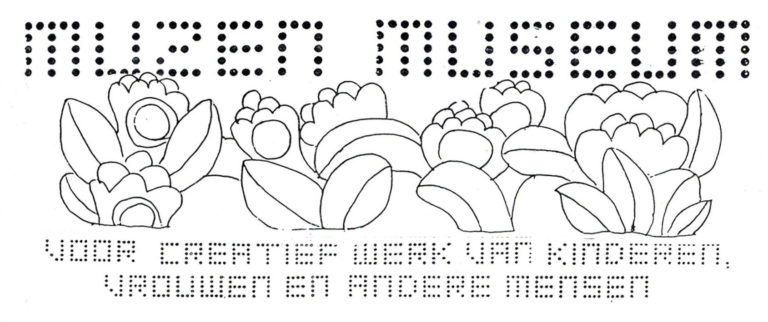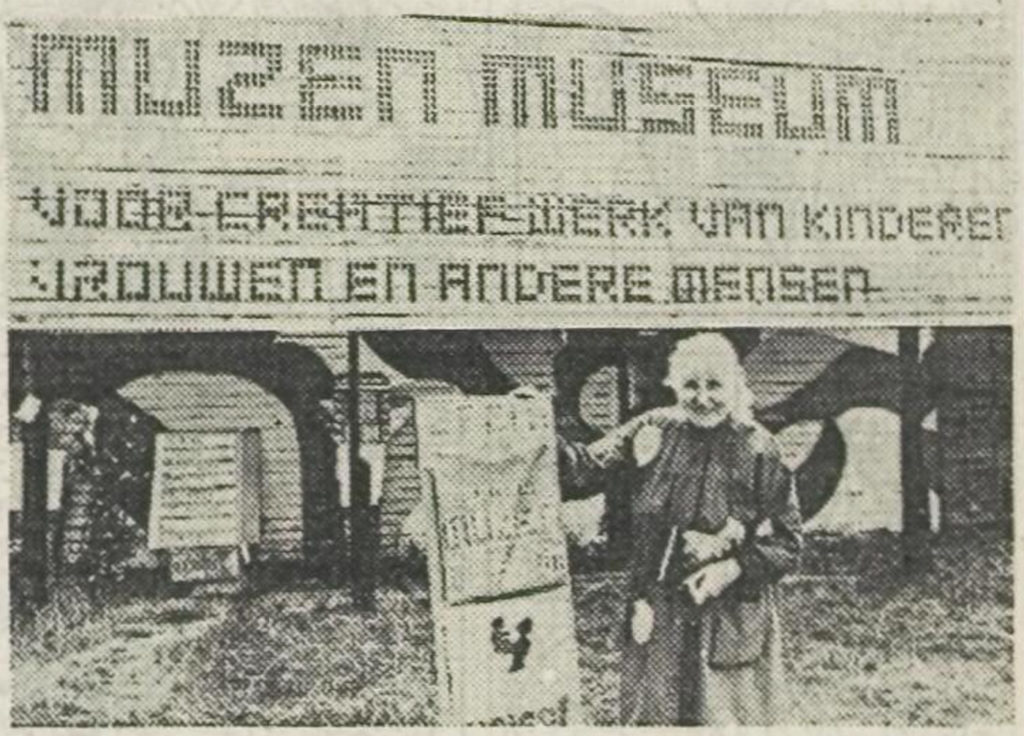The Muse and the Milk Skin (1986)
in Nederlands: De muse en het melkvel
Following in the footsteps of a hundred thousand compatriots, our reporters set out these holiday weeks to give their personal impressions of summer events that may offer the reader a tip for a day out. Piet Snoeren wanted to go to the hospitable abbey of Postel. However, he found the nine muses on his way.
Muzes Museum for creative work by children, women and other people, is written on the fence in peeling letters. Annet Teunissen van Manen: “I am the only museum in the Netherlands where the visitor can indulge all five senses”.
“I started by reusing an empty building. This includes the reuse of empty material. And now I sometimes think I am reusing empty people”. 70-year-old Annet Teunissen van Manen-Zanen beams like a bellflower at this aphorism of her own making. She often does that, beaming so much, because she makes a lot of aphorisms. Another one? “An artist is not a special person, but every person is a special artist”. glee. “When I hear, I forget: when I see, I remember; when I do, I understand”. Glow, shine. The wisdom slips from her smiley mouth like Rhine stones from a broken necklace.
The journey would have led to Postel Abbey. Not entirely out of piety, although the 12th century church of this hospitable Norbertine monastery, with its light dimmed by a crackle of stained glass, always invites a pleasant kind of reflection. No, it had been for the abbey bread, topped with abbey cheese or, better still, abbey ham, washed down with abbey beer from the van, served in sturdy goblets and the color of ebony. It should have been a day at Pallieteren, because the abbey of Postel is located right across the border in Belgium and then people know it. “Cigarettes are cheaper here than in Holland”, advertise signs behind the windows of successive stamineekes. It is not the only and not the main plus.
On the road to Postel, however, south-west of Eindhoven, you will find Bergeyk, in Bergeyk you will find the Muzen Museum and Annet Teunissen van Manen-Zanen. So simple is the explanation for the fact that the abbey will not be made this day. It started, as usual, with surprise. Muzen Museum? The term museum – literally: temple of the muses – is now widely understood, that is true. Everything about tobacco here, everything about beekeeping there. Everything about cheese in Biddinghuizen, while you have to be back in Doesburg for everything about mustard. Everything about Betje Wolff in Middenbeemster, but Betje Wolff was no muse. The Muzes Museum, however? Only the muses can be there. All nine in one place. Clio of music, Thalia of comedy, Melpomene of drama, Terpsichore of choral song, Erato of love poem, Polyhymnia of dance, Oerania of astronomy and Kalliope of epic. The whole lot, plucked straight from the Parnassus and dropped in Bergeyk. “People don’t even know them,” says Annet, full of contempt. “They look around for a while and then ask in a high tone where the mice are. They think I have a mouse museum. People don’t read anymore. They are empty.”
Yet it is fair to say that the thought of mice is not so strange after all. The Muzen Museum, although included in the new travel, ideas and orientation book of the ANWB, mainly resembles a junk attic. All the materials could feel at home in a junk shop or a flee market, the unprepared visitor could be startled on entering. So much time will it take 70-year-old Annet to explain her apparent confusion that Postel Abbey remains a pious mirage for the time being. The nine muses, that is what it comes down to, are not on display in her museum, but are in the visitor himself. The Muzen Museum only serves as an incentive to chase them out of their shells. “I am the only museum in the Netherlands”, Annet beams, “where the visitor can indulge all five senses. Then the inventions will come into being.” As an illustration, an ordinary jam jar is brought out. Rubber is stretched over it so you can drum on it. But there is also a way that you can whistle on it. The jar is half filled with sugar mice; so a rattle. You can also smell these sweets. And taste. Put two senses to work again. The glass of the jar is engraved. You can see and feel that. But you can also engrave the glass yourself. You do that, then you understand. Then you become the special artist that every human being is. “I’m the only museum that has anything to offer the blind”, Annet beams. “Braille, those are dots. Well, gingerbread cookies are dots too. Here: a braille text in them. The blind can read it, feel it, smell it, taste it. Morse code, those are dots and stripes. I was visited by a group of Boy Scouts and then we made a text in Morse code from rolls of textile. Hasn’t it become a dream of a tapestry? An invention. I have been working for fifteen years now and I now have a book full of inventions. Do you know what this is? Parchment? Well, a milky skin. Someone here was wondering if you could do something with the skin that comes on boiled milk. We gave it a try and yes, you can strain over a jam jar. Beautiful, those colours of the dried skin. But I would advise against tasting. Smell maybe”.
Annet once taught at the renowned Rietveld Academy in Amsterdam. She came up with the idea of her Muzen Museum in Bergeyk when she came across the ruins of a burnt-out cinema. “Reuse of an empty building, that’s how it started”. The fence around the ruin is still there. Entry (against payment of 2 guilders, 1 guilder up to the age of 16; open from 2 p.m. to 5 p.m. also on Sundays and public holidays) is only possible through a rickety door. “Muzen Museum for creative work by children, women and other people”, reads on the fence in peeling letters. Offer of the Month: “Turn your street into an avenue. Good for the environment and your house will be worth more. Free trees here”. So this Pallieter returns home, tired, not satisfied with abbey ham and abbey beer, but with a sapling in his hand.
Piet Snoeren
© foundation eye to eye amsterdam 2024


